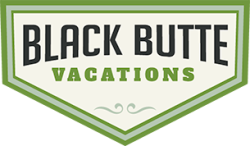The Camp Sherman Store at the heart of Camp Sherman, Oregon
Camp Sherman should be on your list of places to visit and explore on your trip to the Sisters/Black Butte area. It is a small forest community of a couple hundred residents located deep in the Deschutes National Forest. The beautiful spring fed Metolius River, runs down the center of the Metolius Basin and is the central attraction. The Metolius arrises from the ground at the Head of the Metolius (look for the established access area and parking lot off of Metolius River Road). Here you can follow a short paved path down to the headwaters where the river officially begins and a gorgeous view of Mount Jefferson awaits you. Access is provided via private easement, so please be respectful and remain on the path. Pets must always be on leash. Look out for the curious and food-motivated chipmunks who might harass you along the way.

The Metolius features the second highest water quality of any river in the state, second only to a small feeder creek located in the Blue Mountains of north east Oregon. It is considered to be “above drinking water quality” along its entire stretch down to Lake Billy Chinook. We don’t however, encourage you to drink from the river because you never know what contamination might be lurking up the last upstream bend! The quality of the water is quite remarkable, given the many homes and cabins along the river. This is due in large part to the strict rules regarding septic tank inspections, but more so because of the areas geology. The river is sealed off by bedrock along its banks. Camp Sherman is very much a natural setting, but humans have been living alongside nature here since the turn of the last century.
Camp Sherman got its name from some of the first white settlers that began visiting the area and built rustic camps and cabins. They travelled here from Sherman County, Oregon to escape the summer heat and to take a break from the back braking work on their hayfields. Most of these original structures are still standing today. There is even an annual cabins tour that you can participate in, put on by the local historical society. Native Americans, however, had been living, hunting and fishing here for tens of thousands of year prior to white settlement. There are relics and evidence of community sites along the river banks. Sometimes arrowheads and even fishing spear tips are found.
The origins of the name “Metolius” are still disputed, but some think that it means “stinking river” in the native tongue. This was from the thousands of chinook and sockeye salmon that used to migrate, spawn and die up river. It is difficult to image today what a large salmon run must have looked up here, but the last recorded migration occurred in the early 1950s before the building of the Bonneville dam on the Columbia River. Even to this day, fisherman recall fishing for these sea-run monsters in their childhoods. The termination of this fishery caused heartbreak and outrage among angers and nature lovers alike. Today, there are efforts to bring back self-sustaining runs of salmon to the Metolius and the upper Deschutes River Basin.
The Metolius is a remarkable and resilient ecosystem. The loss of ocean-derived nutrients from the dead salmon are sorely missed by the local flora and fauna (humans included!) but nature has a way of adapting. The river is one of only a few in the state where no hatchery trout are released so that wild fish populations can thrive. If you are a fly fisherman, you have probably heard of the Metolius River before and it might even be on your life list of places to visit. The Metolius is a true “testing ground” for the angler. It does not give up its fish easily. If you are lucky enough to catch a fish here, please be very careful and keep your fish wet, don’t drag it into the bank and always pinch your barbs. People practice catch and release, fly fishing only here (by regulation) to help ensure that the population remains healthy and viable. This is a true shared resource by all of us.

